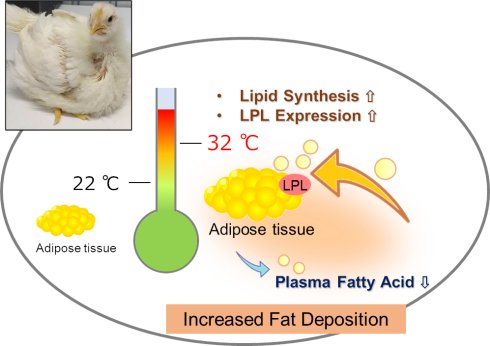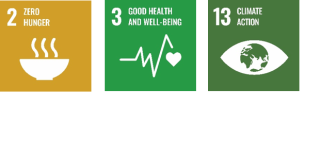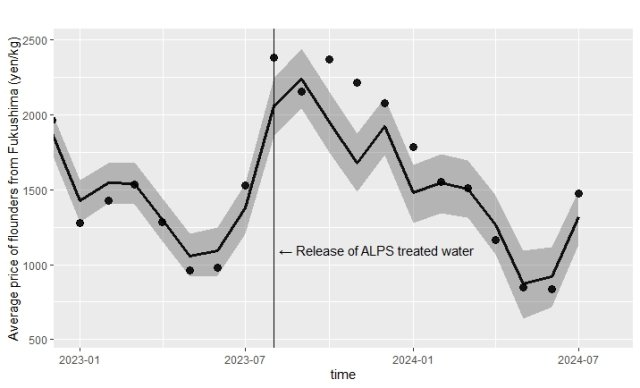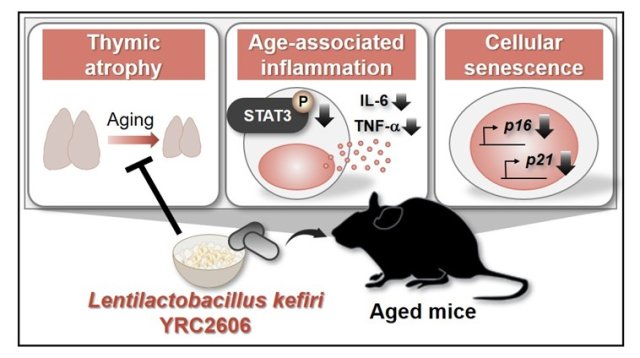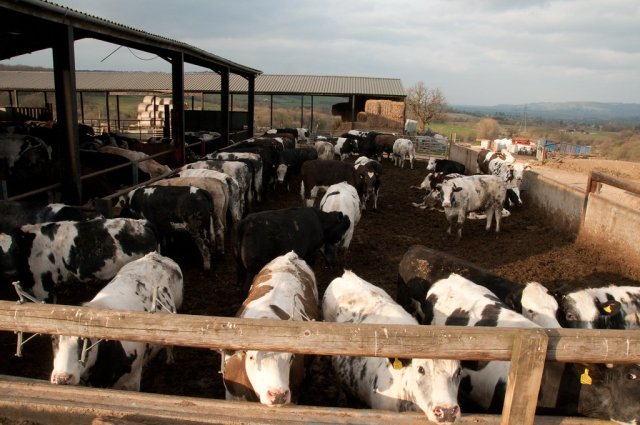Understanding How Heat Stress Reshapes Fat Metabolism in Chickens
- Share
- Tweet
- Send to email
Image title: Overview of what heat stress does to adipose tissue in meat-type chickens
Image caption: This study identified important metabolic changes in adipose tissue in broiler chickens exposed to high temperatures. Higher lipoprotein lipase levels lead to higher fat accumulation, making poultry production less efficient and potentially affecting meat quality.
Image credit: Assistant Professor Yukako Tokutake from Shinshu University
License type: Original content
Usage restrictions: Cannot be reused without permission
Researchers reveal adipose tissue’s active role in promoting fat storage in growing chickens, paving the way to healthier poultry
Broiler chickens, bred for rapid growth, accumulate more fat under chronic heat stress, which reduces meat quality and production efficiency. In a recent study, researchers from Japan revealed that heat stress directly alters fat metabolism in adipose tissue, regulating genes that promote fat storage. Their findings suggest new strategies to mitigate heat stress-related losses in poultry production amidst global warming.
The world’s growing population relies heavily on poultry as a source of protein, making the health and productivity of chickens critical for global food security. However, climate change and rising temperatures pose serious challenges to poultry production. Chronic heat stress, caused by repeated exposure to heat, costs the poultry industry US$128–165 million annually. This is because broiler chickens, bred for fast growth, are particularly susceptible to heat stress. When exposed to prolonged heat, they eat less but paradoxically accumulate more fat relative to their body weight—a puzzling phenomenon that reduces meat quality and production efficiency.
While previous research focused on how heat stress boosts liver fat production, the precise ways for storing this newly made fat throughout the body, especially in adipose tissue, remains largely unknown.
To address this challenge, a research team led by Assistant Professor Yukako Tokutake from the Faculty of Agriculture at Shinshu University, Japan, conducted an in-depth study on how heat stress affects fat storage in the adipose tissue of growing broiler chickens. Their paper, published in Volume 15 of the journal Scientific Reports on May 28, 2025, reveals previously unknown mechanisms that paint a more comprehensive picture of this complex topic. The study was co-authored by Mr. Takashi Miyazaki and Mr. Md. Rezwanul Habib, also from Shinshu University, and Professor Kan Sato from Tohoku University.
The researchers exposed 21-day-old broiler chickens to an elevated temperature of 32°C for two weeks, while maintaining control groups at 24°C. They also included a ‘pair-fed’ group that remained in comfortable conditions but received a limited amount of food equal to what the heat-stressed chickens ate. This experimental design enabled the team to separate the effects of reduced food intake from those of heat stress itself.
The team monitored chickens’ body weight gain, temperature, and various blood measurements related to energy and fat processing. Most importantly, they performed a comprehensive transcriptome analysis on abdominal fat samples from the heat-exposed and control groups to identify genes whose expression levels changed due to heat stress.
Despite significantly reduced food intake, the heat-exposed chickens maintained a ratio of abdominal fat to body weight comparable to the control group. In contrast, the pair-fed group showed a marked decrease in fat accumulation, suggesting heat stress actively promotes fat deposition, rather than simply being a consequence of eating less. Furthermore, the heat-exposed group exhibited lower levels of free fatty acids in blood, indicating a complex adjustment in how their bodies handle fat in response to heat.
Through molecular analyses, the researchers obtained deeper insights into these changes. They identified 459 genes that showed different expression levels in adipose tissue in the heat-exposed group. For example, multiple genes crucial for fat storage and synthesis were more active, such as lipoprotein lipase (LPL). Conversely, genes involved in breaking down fat, like adipose triglyceride lipase, showed decreased activity. Experiments involving cultured adipose tissue cells further supported these findings, showing that direct heat stimulation alone could increase LPL activity in cultured chicken fat cells.
Taken together, these findings represent a significant shift in our understanding of how heat stress affects fat deposition in broilers. Whereas previous research focused on the liver as the central fat production organ, this study reveals that adipose tissue plays a more direct and active role than previously thought. “Our study is the first to demonstrate that enhanced LPL expression, which is involved in lipid uptake and triglyceride synthesis in adipose tissue, probably contributes to the increased fat accumulation observed in broilers under heat stress,” notes Dr. Tokutake.
This research has important implications for the poultry industry, especially as global temperatures continue to rise. Increased fat accumulation in broilers means they are not efficiently converting their feed into valuable meat, leading to economic losses. By identifying the specific processes happening in adipose tissue, the study opens new avenues for action. “Regulating fat metabolism through feed additives could be a viable strategy to maintain poultry health and enhance meat quality,” remarks Dr. Tokutake. “Selectively breeding for enhanced heat stress resistance is another option.”
Further efforts in this field will hopefully lead to more sustainable and resilient poultry production, contributing to food security in a warming world.
|
Reference |
||
|
Title of original paper: |
Chronic heat stress facilitates lipoprotein lipase expression and triglyceride biosynthesis in the adipose tissue of growing broiler chickens |
|
|
Journal: |
Scientific Reports |
|
|
DOI: |
||


